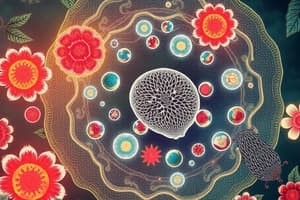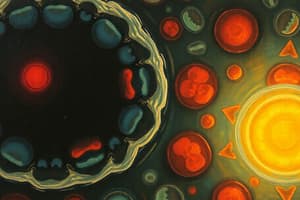Podcast
Questions and Answers
Which organelle is responsible for the synthesis of proteins and is found both free-floating and attached to the rough endoplasmic reticulum?
Which organelle is responsible for the synthesis of proteins and is found both free-floating and attached to the rough endoplasmic reticulum?
- Mitochondria
- Golgi Apparatus
- Ribosomes (correct)
- Nucleus
What is the primary function of the smooth endoplasmic reticulum (SER)?
What is the primary function of the smooth endoplasmic reticulum (SER)?
- Lipid synthesis and detoxification (correct)
- Production of ribosomes
- Cellular respiration
- Protein modification and transport
Which organelle is responsible for packaging and modifying proteins and lipids for transport within the cell?
Which organelle is responsible for packaging and modifying proteins and lipids for transport within the cell?
- Nucleus
- Golgi Apparatus (correct)
- Lysosomes
- Mitochondria
Which of the following structures is found only in plant cells and is responsible for photosynthesis?
Which of the following structures is found only in plant cells and is responsible for photosynthesis?
What is the main function of the cell wall in plant cells?
What is the main function of the cell wall in plant cells?
Flashcards
Nucleus
Nucleus
Controls cell activities and stores genetic information (DNA).
Ribosomes
Ribosomes
Synthesize proteins; can be free-floating or attached to rough ER.
Mitochondria
Mitochondria
Produces ATP (energy) through cellular respiration.
Chloroplasts
Chloroplasts
Signup and view all the flashcards
Cell Wall
Cell Wall
Signup and view all the flashcards
Study Notes
Common Organelles in Animal and Plant Cells
- Nucleus: Controls cell activities, stores DNA
- Nucleolus: Produces ribosomes within the nucleus
- Nuclear Envelope: Double membrane with pores, regulates nuclear material exchange
- Cytoplasm: Jelly-like substance, supports organelles, facilitates material movement
- Cell Membrane (Plasma Membrane): Controls what enters/exits the cell (selective permeability)
- Ribosomes: Synthesize proteins, can be free-floating or bound to rough ER
- Rough Endoplasmic Reticulum (RER): Modifies and transports proteins, studded with ribosomes
- Smooth Endoplasmic Reticulum (SER): Synthesizes lipids, detoxifies harmful substances
- Golgi Apparatus: Modifies, sorts, and packages proteins/lipids for transport
- Mitochondria: Produces ATP (energy) through cellular respiration
- Peroxisomes: Breaks down fatty acids, detoxifies harmful substances
- Cytoskeleton: Provides cell shape, support, and movement
- Vesicles: Small sacs for transporting materials within the cell
Organelles Unique to Plant Cells
- Cell Wall: Provides structural support and protection, composed of cellulose
- Chloroplasts: Conduct photosynthesis, converting light energy to chemical energy
- Large Central Vacuole: Stores water, nutrients, and waste; maintains turgor pressure
- Plasmodesmata: Small channels connecting plant cells, facilitating communication and transport
Organelles Unique to Animal Cells
- Centrioles: Help organize spindle fibers during cell division
- Small Vacuoles: Store nutrients, waste, and other substances (smaller than plant vacuoles)
- Lysosomes: Digest waste, food particles, and old organelles (less common in plants)
Studying That Suits You
Use AI to generate personalized quizzes and flashcards to suit your learning preferences.





